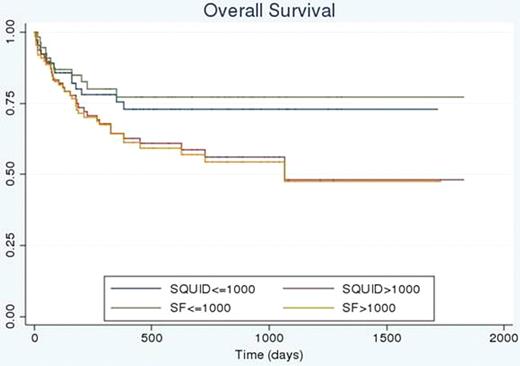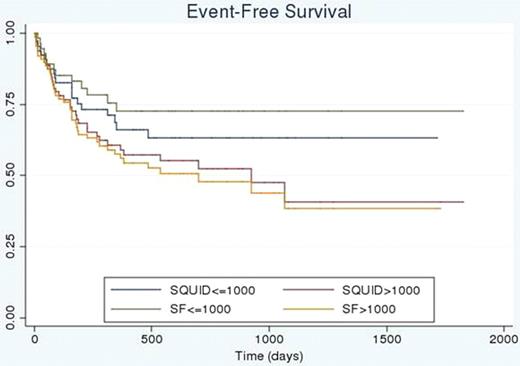Abstract
Abstract 1018
There is conflicting data regarding the role of serum ferritin (SF) as an independent prognostic factor for outcome after allogeneic stem cell transplantation (allo-SCT). SF is a surrogate parameter for iron overload and - as an acute phase-protein - can be confounded by many factors. An independent, non-invasive measurement of iron overload is needed. Determining iron content through SQUID correlates well with results of liver biopsies (Nielsen et al. 1998). This method measures the interference of an exteriorly applied small but highly constant magnetic field by the paramagnetic liver storage iron of the patient.
We conducted a single-center retrospective analysis from October 1994 to December 2012, comparing the effect of SF and liver iron content measured by SQUID shortly before transplantation on overall survival (OS), event-free survival (EFS) and transplant-related mortality (TRM) in 143 patients (median age 40 years) undergoing allo-SCT (73% reduced intensity regimen). The diagnoses were subdivided into 4 groups: myelodysplastic syndrome, secondary acute myeloid leukemia (AML), primary myelofibrosis, primary AML and other. Statistical calculations employed Pearson's correlation, ordinal logistic regression, Cox regression analysis and multiple Cox regression analyses with backward elimination.
Correlation between SF and SQUID showed a highly significant result of r=0.5 (p < 0.001). The chance of infection was increased 2.4-fold (CI 1.22,4.71) when SQUID values ranged > 1000 μg Fe/g liver. We found similar results for SF > 1000 ng/ml (p 0.003), where the risk of infection was increased 2.87–fold (CI 1.43;5.78). A significant association between SQUID und fungal infection was also seen (p 0.004). For patients with SQUID > 1000 the chance of proven fungal infection versus fungal infection of all other categories was increased 3.08-fold (CI 1.43,6.63). Similarly an association between SF > 1000 and fungal infection could be demonstrated (p 0.001), with a 4.04-fold increased chance of proven fungal infection versus lower fungus categories for patients with SF values > 1000. There was no association between continuous SQUID-, respectively SF values and VOD (veno-occlusive disease) or acute GvHD. The following variables were significantly related with OS: chronic GvHD (HR 0.326, CI 0.13–0.83, p 0.019,), sepsis (p 0.002, HR 2.94 CI 1.48–5.83), new onset cardiac abnormalities (p 0.001, HR 3.21, CI 1.64–6.27), SF > 1000 (p 0.033, HR 2.09, CI 1.06–4.11). For EFS we found statistically significant results for chronic GvHD (p 0.040, HR 0.45, CI 0.21–0.97), sepsis (p 0.012, HR 2.35, CI 1.21–4.58), cardiac abnormalities (p 0.001, HR 2.81, CI 1.50–5.29), SF > 1000 (p 0.016, HR 2.15, CI 1.15–4.10) and time to engraftment (p 0.038, HR 0.934, CI 0.89–1.00). For TRM, statistically significant results were found for sepsis (p 0.005, HR 3.23, CI 1.43–7.29), cardiac abnormalities (p < 0.001, HR 5.21, CI 2.41–11.27), and age (p 0.034, HR 1.04, CI 1.00–1.08). Fungal infection of all categories was not statistically significant (p=1,101), but proven fungal infection in comparison with no fungal infection was found significant (p 0.018, HR 3.12, CI 1.22–7.99. In the multivariate analysis SF and SQUID (categorical and continuous) were not significant factors for OS, EFS or TRM.
Our data confirmed previous publications that SF > 1000 increases the risk of infection, moreover fungal infection. In the univariate analysis it is significantly associated with OS and EFS during allo-SCT. As SQUID values correlate well with SF, we could show that SF is indeed a good surrogate parameter for iron overload when measured shortly before allo-SCT. We are now in need of prospective trials investigating the effect of iron chelation before or during allo-SCT on transplant outcome.
No relevant conflicts of interest to declare.
Author notes
Asterisk with author names denotes non-ASH members.




This feature is available to Subscribers Only
Sign In or Create an Account Close Modal